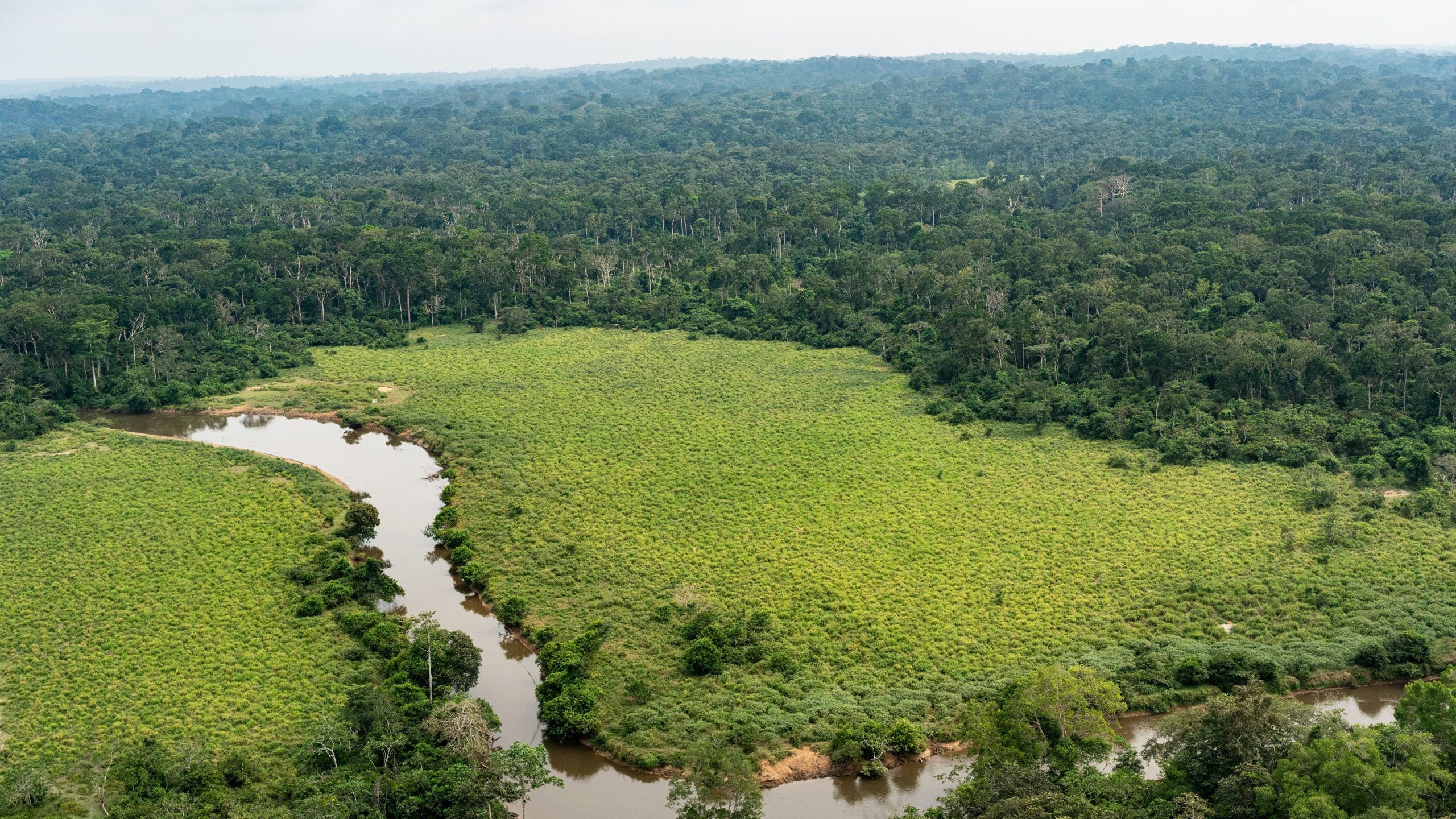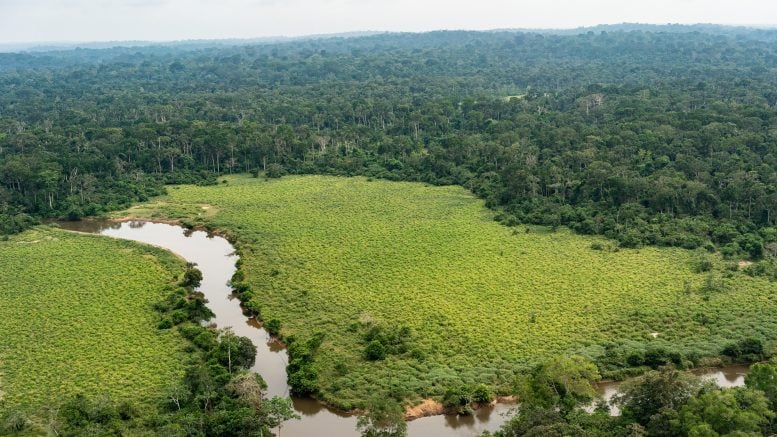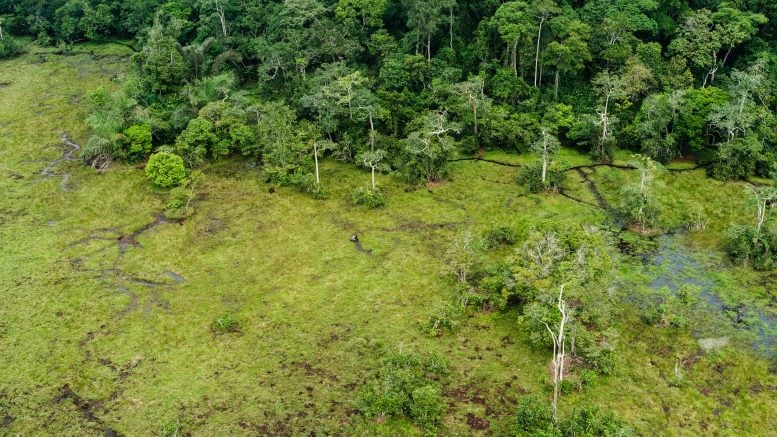

Exploring the vast canopy gaps of the Congo rainforests.
When you think of a “tropical rainforest,” images of tightly packed trees, heavy humidity, and the sounds of wildlife might come to mind. However, rainforests also feature a variety of landscapes beyond that typical scene, including wide, open clearings that seem to emerge unexpectedly.
These strange, sudden canopy gaps, called bais, are located only in the rainforests of the Congo Basin of west-central Africa. Some stretching the length of 40 football fields, and some only a few hundred feet across, bais are the world’s largest known natural forest clearings, and they seem to play a big role in the rainforest’s highly complex, biodiverse environment.
Yet due to their remote nature, bais have been rarely studied –how many exist, where they are, and what ecological communities they intersect. Harvard researchers are now trying to write the playbook on bais to provide greater insight into their place in the overall forest ecosystem.
New Insights from Harvard Researchers
A new study in the journal Ecology provides an unprecedented, detailed overview of bais’ layout, makeup, and abundance across more than 5,000 square miles of conserved forest in Odzala-Kokoua National Park, Republic of the Congo. Culminating more than two years of field study, the work was led by Evan Hockridge, a Griffin Graduate School of Arts and Sciences student in the lab of Andrew Davies, assistant professor in the Department of Organismic and Evolutionary Biology.
“This was a huge data collection effort, involving everything from drones to soil measurements to camera trapping to identification of plant species,” Hockridge said.

Hockridge originally set out to study how large African animals engineer their own ecosystems, but quickly realized megafauna cannot be understood outside the bais they inhabit. “Animals are extremely attracted to these giant clearings in the middle of the forest, including many endangered animals like the Western lowland gorilla and the African forest elephant,” Hockridge said. “These keystone conservation priority species will spend enormous portions of their lives basically just moving between bais.
Coming upon a bai after hiking through thick canopies of trees is “stunning,” according to Hockridge, who spent several months of 2021 in Congo collecting data and leading teams. Without warning, the trees stop, opening into a clearing where forest buffalo often lounge among short grasses and sedges. A stream cuts through the expanse. Flocks of a thousand African green pigeons land nearby to gather salt and other soil nutrients. “It’s like something out of a picture book, but the picture book doesn’t exist,” Hockridge said.
Advanced Mapping Techniques Reveal More Bais
For their study, the scientists developed a technically sophisticated remote-sensing protocol using drone-based Light Detection and Ranging (Lidar) and satellites, producing models and maps of bais across the vast landscape of the Congo basin. They found many more bais than anyone had expected – more than 2,000 distinct ones in the national park, as opposed to the informally counted 250 or so.
Yet the total amount of habitat bais encompass is quite small – less than 0.2 percent of the entire national park, according to the research. Varying in size, they also tend to be clustered together. This is potentially good news for conservation efforts, Hockridge said, because bai habitat is present in a relatively small portion of the total landscape.
The researchers’ analysis also unveiled a tantalizing new insight into the biological makeup of bais: stark differences in plant compositions between bais frequented by gorillas, versus those frequented by elephants. They’re not sure why.
“There’s a great need to understand what’s happening with these bais because they’re so important to organisms we’re trying to conserve,” Hockridge said. “Our goal is to understand how animals are interacting with these clearings. Are they making them? How dependent are they on them? Are these clearings stable over time?” Their next study may delve deeper into these questions, Hockridge said.
Paper authors include collaborators Gwili Gibbon, head of research and monitoring at Odzala-Kokoua National Park, and Sylvain Ngouma and Roger Ognangue, research “ecomonitors” at the national park who served as the Harvard team’s local experts in the area’s biology and botany.
“This work would have been impossible without them,” Hockridge said. “They’re the most quintessential partners in the work we do.”
The Congo Basin’s rainforests offer so much more than just the carbon they store, noted Davies, “and we are still just barely scratching the surface of what we know about them.”
“This study helps us understand a little bit more about their functioning, and the treasure trove of biodiversity they hold, which only inspires and excites us to keep exploring and discovering more of their secrets,” Davies said.
Reference: “Spatial ecology, biodiversity, and abiotic determinants of Congo’s bai ecosystem” by Evan G. Hockridge, Ella M. Bradford, Katherine I. W. Angier, Beatrice H. Youd, Elijah B. M. McGill, Sylvain Y. Ngouma, Roger L. Ognangue, Gwili E. M. Gibbon and Andrew B. Davies, 01 October 2024, Ecology.
DOI: 10.1002/ecy.4419